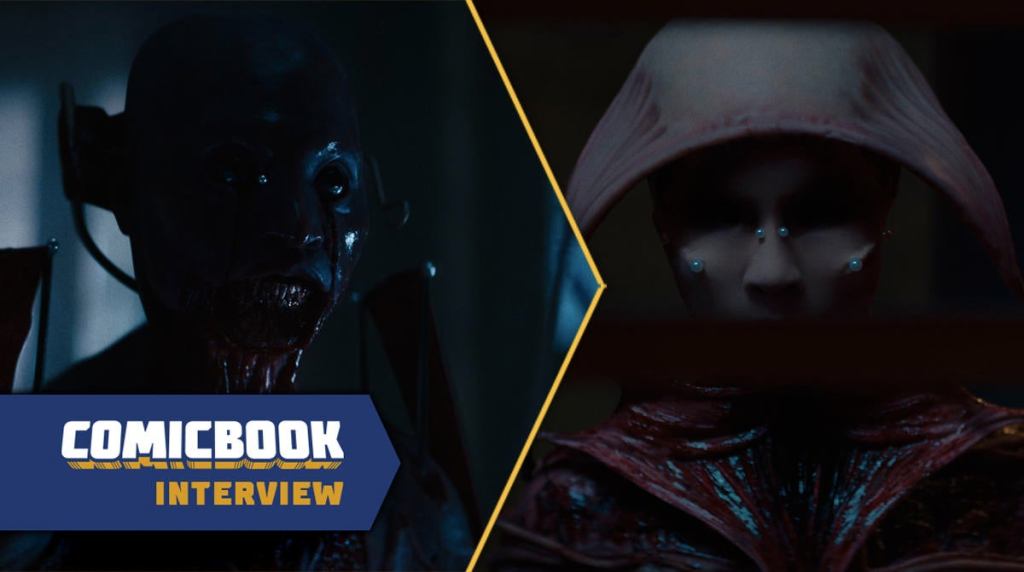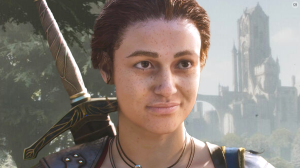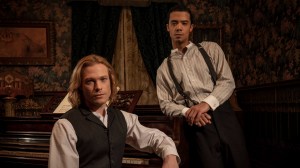A key component of any Hellraiser film are the monstrous and memorable Cenobites, the most famous of which being the Hell Priest, a figure many fans would know as “Pinhead.” While this figure has been a staple of all incarnations of the film franchise, each installment also features a number of other Cenobites, all of which bring with them ghastly and grotesque appearances, evoking both curiosity and terror in audiences. For the new Hellraiser on Hulu, the franchise has added Jason Liles as “The Chatterer,” Selina Lo as “The Gasp,” and Yinka Olorunnife as “The Weeper.” The new Hellraiser is now streaming on Hulu.
Videos by ComicBook.com
In the all-new Hellraiser, a young woman struggling with addiction comes into possession of an ancient puzzle box, unaware that its purpose is to summon the Cenobites, a group of sadistic supernatural beings from another dimension.
ComicBook.com caught up with the new Cenobite actors to talk joining the franchise, the makeup process, and more.

ComicBook.com: There’s a long history of Chatterers, and, other than the Hell Priest, is definitely one of the more iconic figures in the series. When it came to you finding out that you got to be The Chatterer, did you feel maybe undue pressure, knowing the passion for that character in the franchise? How did you navigate wanting to honor the legacy, but also doing your own thing with it?
Jason Liles: That’s a great question. I didn’t really feel pressure. I’m very much a, not even glass half full, but a glass is overflowing guy. They’re like, “It’s so hot.” “I know it’s great we’re able to sweat out all the toxins. Isn’t it awesome?” I’m that kind of guy. When I got this, I just focused on the positives, like, “Wow, this character’s been around for 35 years. People already love him. So cool I get to jump in and play a version of him.” That was really just exciting. I really wasn’t nervous at all. And then how we honored Chatterers of before while making him new here, was, obviously, physically he looks similar but different. I looked all the way back to the original Nicholas Vince in the 1987 film and I watched 1 and 2 and talked a lot with [director] David [Bruckner] about who is this character? What’s different? What’s similar?
Then once we got on set, David’s just such an amazing director and really helped us bit by bit to find, how does this character move? Very specifically, just a lot of walking from point A to point B for an hour or two one day, just what feels right, and then a lot of talking about who is this character on the inside? Why is he doing this? Why does he chatter? Why do his teeth chatter? Which, we had ideas about that I’ll keep secret for now, but we have ideas of why, it’s not just random, but having someone like David guiding you there is so helpful. He’s an incredible director.
Tacking on to what Jason just mentioned about backstories, there’s deep-rooted mythology to these Cenobites, there’s a reason why they are the way they are. How much of that was David telling you, “This is the entire backstory, this is how you got to this point,” versus you potentially being allowed to fill in the own details that we never really got to see in the movie itself?
Selina Lo: Well David was very generous in just giving us freedom. He let me know that this is an original character, but I obviously took influences from the original Cenobite who was Pinhead’s right-hand woman and a lot of the focus really, was on the physicality, because I feel like that’s so important with the Cenobites. From the way that they walk to the way that they speak.
My character is called “The Gasp,” her throat is wide open, so there’s lots of variations, we worked out a lot of just talking on the exhale, talking on the inhale, drying out your throat, just creating that sound, and then also the movement that just works with the Cenobites and what they represent and how they come across and how poised and regal they are. So a lot of focus was on that.
Jamie Clayton’s character is, in the book, referred to either as a Hell Priest or as lead Cenobite, Pinhead didn’t come until the fans nicknamed them. Jamie’s character is a leader of the Cenobites, so for your character, for your Cenobite, do you collaborate with her to find out how you might connect to her character? Or did you even say, “This is how I’m going to set my Cenobite apart from her and the others,”?
Yinka Olorunnife: To be honest, I didn’t collab with any of the other Cenobites. I don’t want to speak for anyone else, but I think, at the end of the day, Cenobites, we were once human and then turned into Cenobites. I think we individually had to create our own backstory and think of ourselves as who are we as individuals and who are we as a team. My collabs came with David and so, for The Weeper, with David, movement was one big thing, but then obviously the weep. What is the weep? What does the weep sound like? I had some ideas, like I wasn’t sure if it was, thinking about pleasure and pain, is my weep really high-pitched? Low-pitched? Is it more sexual and almost orgasmic? Am I proper crying?
David actually had me watch, is it Midsommar with Florence Pugh? There’s a scene towards the end of the movie where, without spoiling it, a scene towards the end of movie where there’s like this group crying together. David told me to pay attention to that scene because when he imagines The Weeper, he really sees influence from this. Then I watched that and I loved it, so I took that as guidance and just as influence, and then I had to create my own backstory to be able to figure out, why am I weeping? What am I weeping? What does my weep mean? How do I change? Does my weep change? Is it the same weep? So all these things were going on in my head.
My collaboration came more with David, but I think once you get on set with the other Cenobites — and not every Cenobite were in scenes together, like Jason, The Chatterer, he’s not in any scenes with Weeper and Gasp, I don’t think with Gasp. But when you are with the other Cenobites, you do get this element of like, these are my teammates, these are my people. You’re just like, this is my crew, what’s up humans? There’s this natural confidence that comes out when you’re together.
What was your first reaction to seeing yourself in your makeup? Because you’re watching over the hours to put it on, was there a disconnect between the final form and who you really are? Or because you saw what went into it, it was a more gradual transition process?
Olorunnife: It was a gradual process, but beforehand, before we even got into the suits, David had already shown us what the concept art looked like, so I knew what I was going to roughly look like. But to see yourself for the first time as a full Cenobite, it’s this moment of awe. It’s this moment of just like, you’re just so fascinated by the work that the Russells put in, Sierra and Josh. It’s this overwhelming feeling, and I can’t explain it. You feel proud, you feel honored, you are fascinated, you’re excited, all those emotions come out and then you’re looking at yourself and you’re like, “Look at me. Look at The Weeper go. Look at my shoulders. Look at my feet.” It’s quite exciting.
Continuing that, the makeup itself, is it as comfortable as it can be? Is it a completely comfortable process that you didn’t mind being in for a few hours or was it the type of thing where it maybe does give you a little bit of an out-of-body experience? How did the makeup transform your own performance?
Lo: Well because my application took about five, six hours, I’m already in the makeup chair for a long time before I’m even on set. But Sierra and Josh, and not just them, the whole team, because we had a great number of very talented prosthetic artists that worked on me simultaneously and they were just so wonderful, always made sure that I was as comfortable as I could possibly be and we would have a laugh up until the point they had to do my face and my neck, because we’ve got these specific pieces that were made for my face, that I need to be very still for. Then that was the time that I would take before getting to set to just get into The Gasp’s head space, so it’s great. I had that time with them and I loved them so much. Then I had that time, because there was so much time getting ready, to get into that head space.
I do want to say, because we were talking about the process and how did you feel, it was gradual and I don’t think I felt the full effect of it until I was around other people. We were filming at Voight’s Mansion and it was really cold out and so I’d gone inside to just get warm for a couple of minutes and it’s a big place. I went to an empty room and was standing behind the door to shield myself from the wind and one of the camera guys came in, did not know I was there, screamed, grabbed his chest, made the sign of the cross, ran away speaking Serbian and I felt awful. Then I had his friends coming up to me going, “He thought he was having a heart attack.” He actually thought he was having a heart attack and I felt so bad. But it’s also a testament to the Russells, as to how incredible and terrifying and shocking they made us look.
I think a lot of people might, especially because Pinhead came out in the ’80s at the time of Freddy Krueger and Jason Voorhees, he gets lumped in, and the Cenobites might get lumped in with other movie monsters, but what do you feel it is about the Cenobites, and therefore about Hellraiser, that really sets them in a category all their own? What really makes them stand apart from any other movie monster?
Liles: That’s a really good question. I think so many others are just very simple and sometimes simple is best, that’s not a bad thing in the way that they’re a slasher or they’re just going to come after you and they kill you. I feel like the Cenobites, they’re so much deeper, and especially if you get taken to become a Cenobite, it’s not just quick and over and you’re dead. You now have an eternity. It’s like you go to Hell for all eternity, no takebacks, and there’s no way out of it. You can only go deeper, and there’s something very unsettling about that.
But then they’re also supernatural and so it’s not like, “Oh, we just got to kill them and we’ll be okay.” They’re from another dimension, they can really go between … You can’t really get away from them, unless you have the wrought-iron gates at Voight’s house with the magical whateverness that keeps them trapped or out.
I can’t really think of too many where, it’s not that they’re just going to kill you, but they want to convert you, they want to bring you, it’s so deep. And they prey on your desires and they prey on your sins and all this. It’s a lot deeper than just physical, it really gets into a soul level of haunting and you make a mistake eternally, you’re screwed.
The new Hellraiser is now streaming on Hulu.
This interview has been edited for length and clarity. You can contact Patrick Cavanaugh directly on Twitter.








